The truth is that back-to-back days are fantastic! However, isolating your back muscles will require them to work harder, which will help you create a larger back. Hammer Strength Rows are one of the greatest exercises for targeting your back muscles directly.
Free weight exercises might make it harder to feel your back muscles, which is a concern with back training. Don’t get me wrong: you must do workouts like barbell and dumbbell rows.
Other workouts that target certain angles of your back muscles should also be included in your routine. This is what gives you the complete three-dimensional bodybuilder physique.
In this article you will discover how to create a larger back using 3 kinds of iso-lateral row machines Hammer Strength:
[table id=11 /]
I will also show you how these machines may be integrated into your back exercises and how you can complete back training with these three machines.
Hammer Strength Iso-lateral Rows Benefits
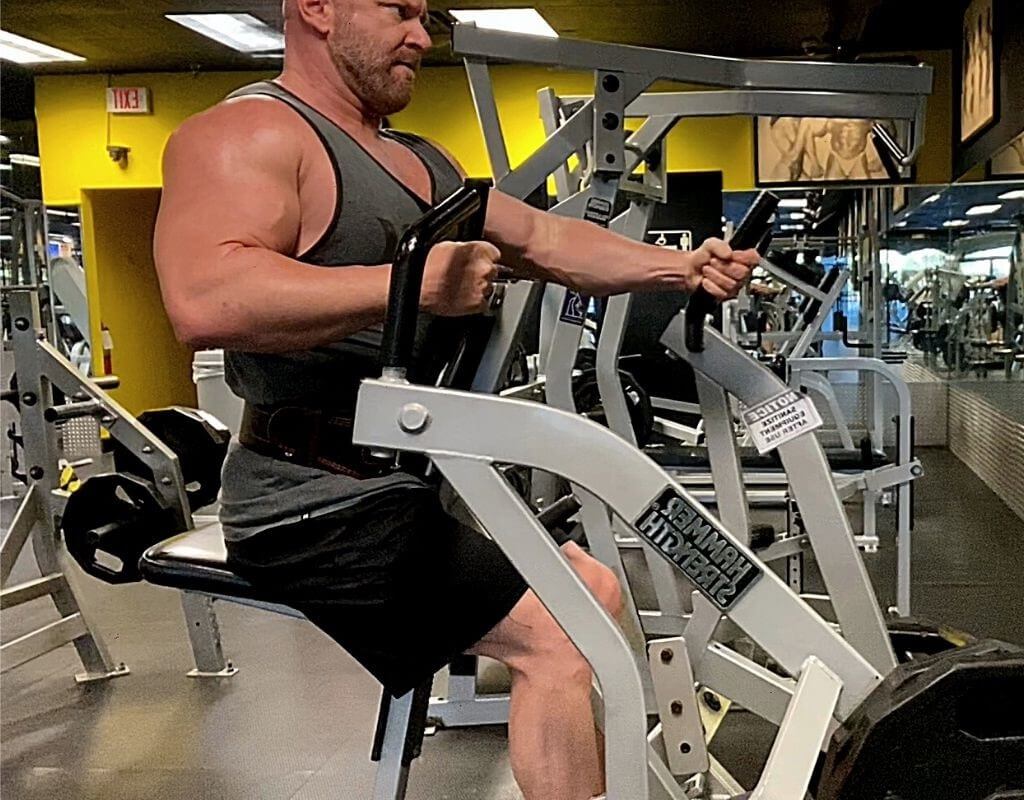
What are iso-lateral rows, first and foremost?
In bodybuilding words, iso-lateral simply refers to the capacity to exercise one side of your body at a time.
This implies you may train one side (and certain sections) of your back muscles while doing rows.
Iso-lateral rows by Hammer Strength are identical to dumbbell rows in that sense. The Hammer Strength machines, on the other hand, let you directly target your back muscles without having to balance or rely on other muscles for support throughout the workout.
The following are some ways that Hammer Strength Iso-lateral rows might help you create a larger back:
[table id=12 /]
3 Iso-lateral Row Machines with Hammer Strength
Let’s take a look at the three different sorts of rows you can perform with Hammer Strength equipment. All of these machines are iso-lateral row machines for back training.
In this part, I’ll also discuss the many ways you may use each equipment. This will allow you to add additional diversity and alternatives to your back routines. As you may be aware, it is beneficial to vary your training routine from time to time. Iso-lateral row machines come in a variety of shapes and sizes, but I’ll focus on the three most prevalent Hammer Strength back machines found in most excellent gyms. They should, at the very least, have them!
Hammer Strength Low Row Iso-lateral
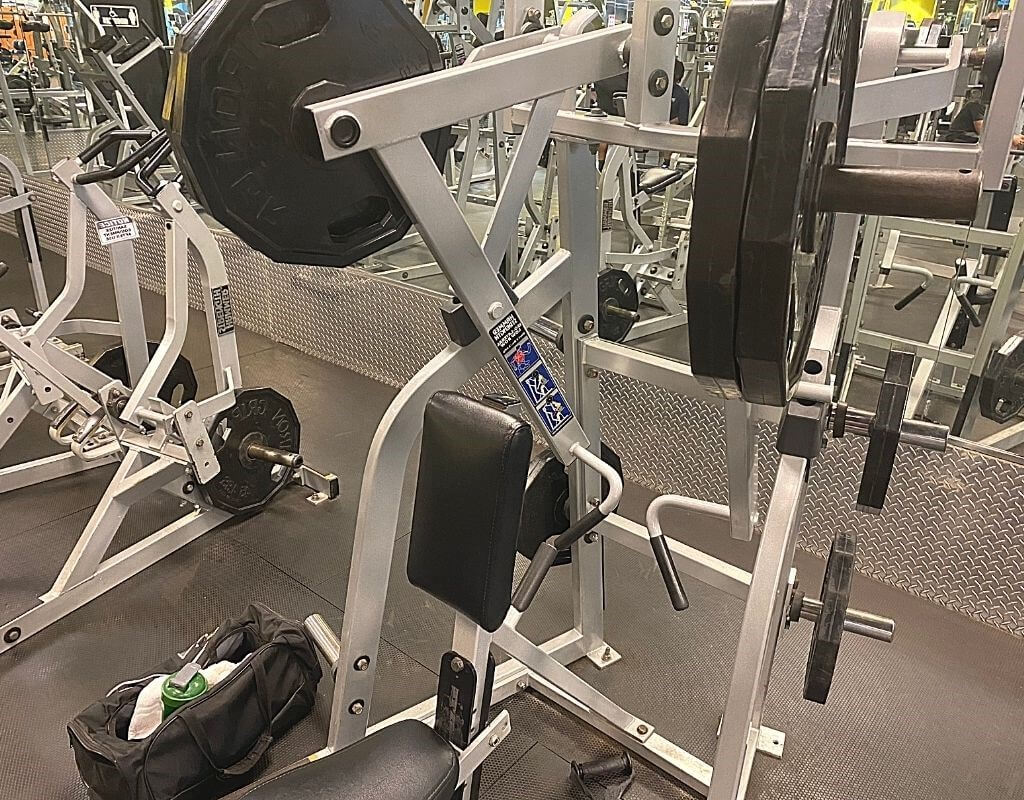
Low row iso-lateral is comparable to dumbbell rows. Even if you’re sitting, your body is erect while you have to reach down to grasp the handle.
As you pull the handle towards you, you can really target your lats and upper back muscles.
Hammer strength iso-lateral low rows:
- Adjust your seat so that your arm is at a 90-degree angle as you pull (be sure you’re not pulling too high or too low).
- While executing the exercise, keep your torso close to the pad.
- You may do these exercises with both arms or just one (you may feel that single-arm is more effective)
- When you reach the top of the handle, flex your lats firmly.
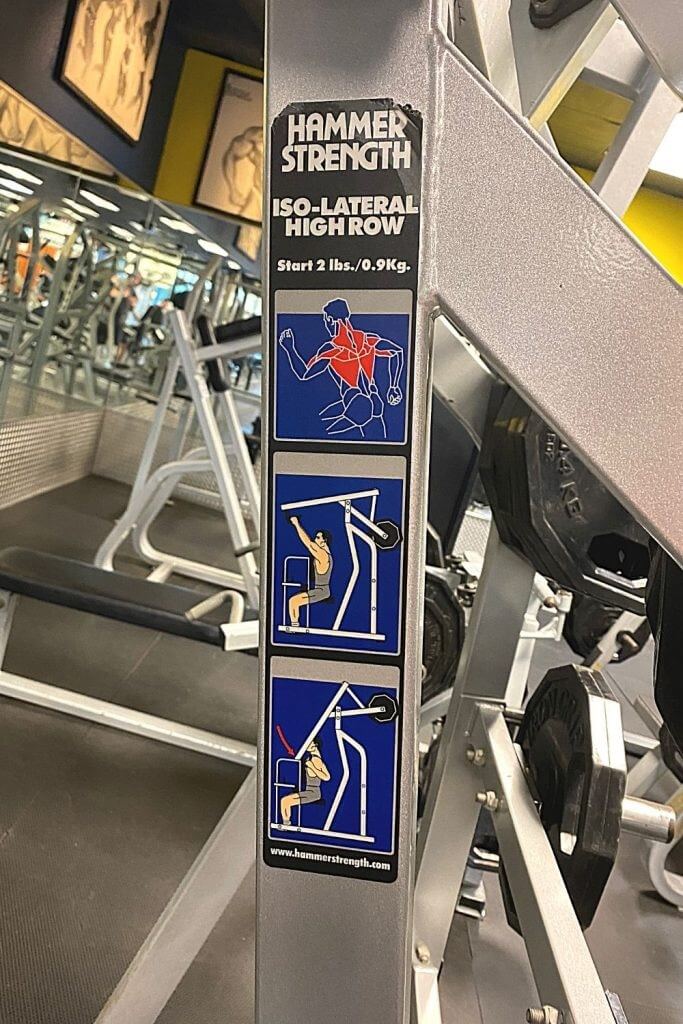
Although you can pull with both arms at the same time, I find that pulling with just one arm is more effective. This method allows you to get a greater muscular contraction as well as a deeper stretch without having to move your body too far away from the pad.
Hammer Strength High Row Iso-lateral
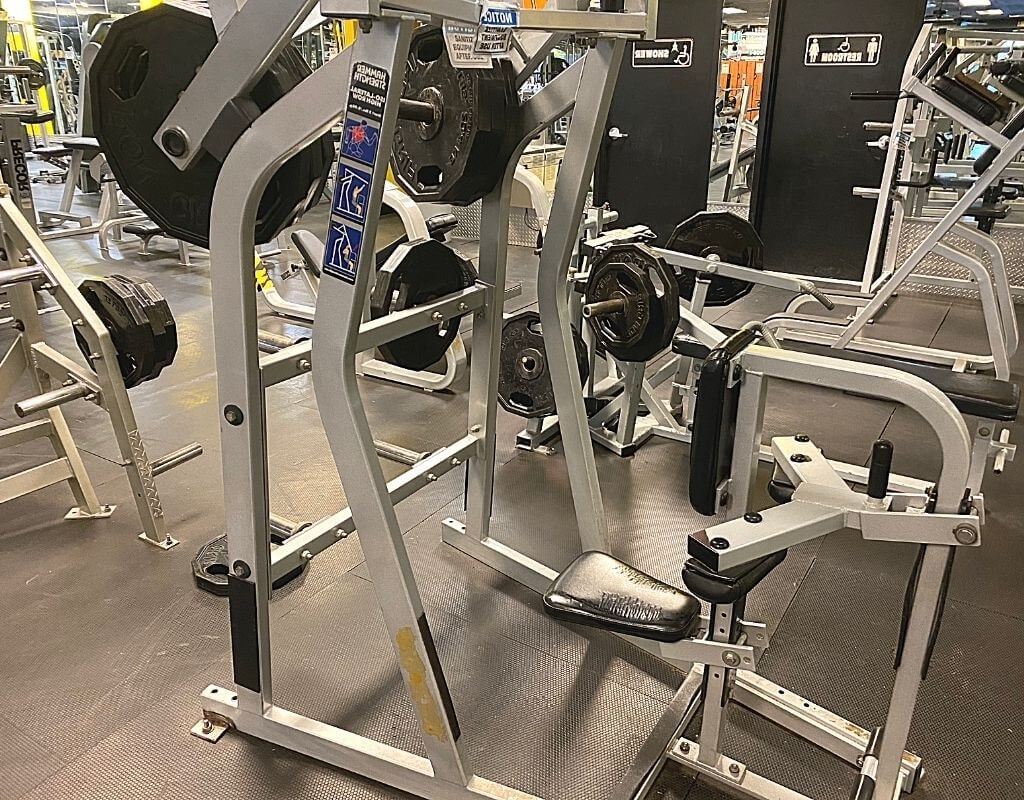
At first glance, the iso-lateral high row may seem to be a variation of the lat pulldown. The primary distinctions are that your grasp will not be as broad as a traditional lat pulldown and that the Hammer Strength machine will allow you to pull in deeper.
The lower lats are targeted in this variation of the Hammer Strength rows. You’ll also notice that the muscles in your lower-middle back are functioning.
It may be claimed that the high pull version provides the greatest range of motion compared to the standard or low iso-lateral low machines (albeit they both have a good range of motion!).
How to perform iso-lateral high rows using Hammer Strength:
- Check that your seat height isn’t too low or too high, so you’re exercising your back from the optimum position possible (start out with light-weight to see what setting works best for you)
- You may lean back somewhat, but make sure your tummy stays on the pad.
Pull in your back muscles and attain a nice stretch at the top by contracting your back muscles.
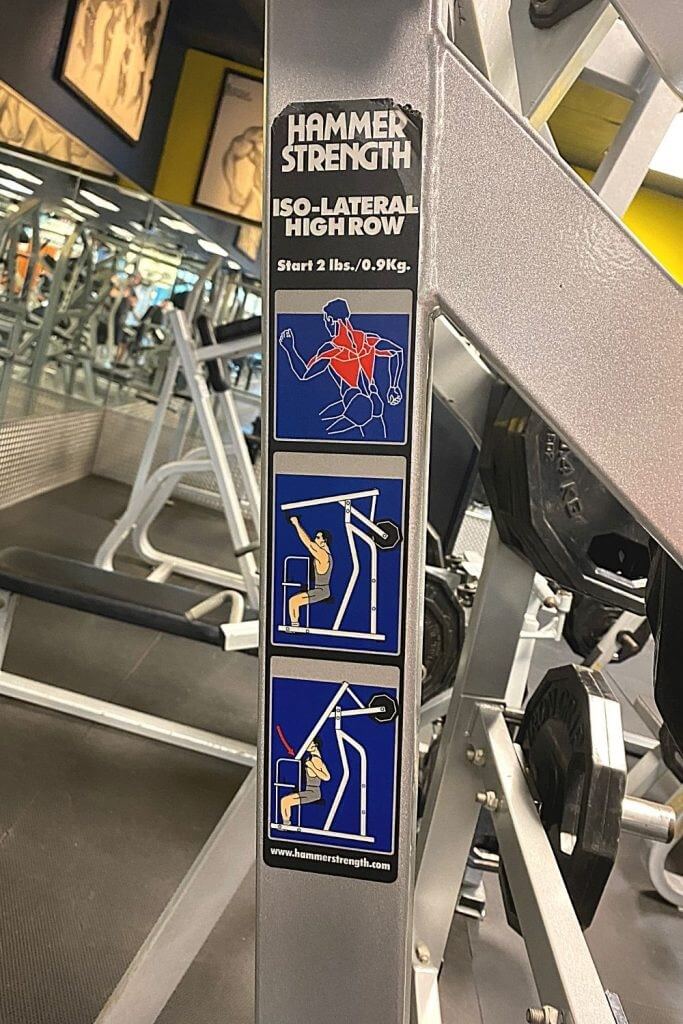
When it came to low rows, I harped on the advantages of performing them with only one arm. However, I’ve discovered that pulling with both arms at the same time works best for high rows (this is just my personal taste; it doesn’t mean it’s the best for everyone!).
Iso-lateral Row Hammer Strength
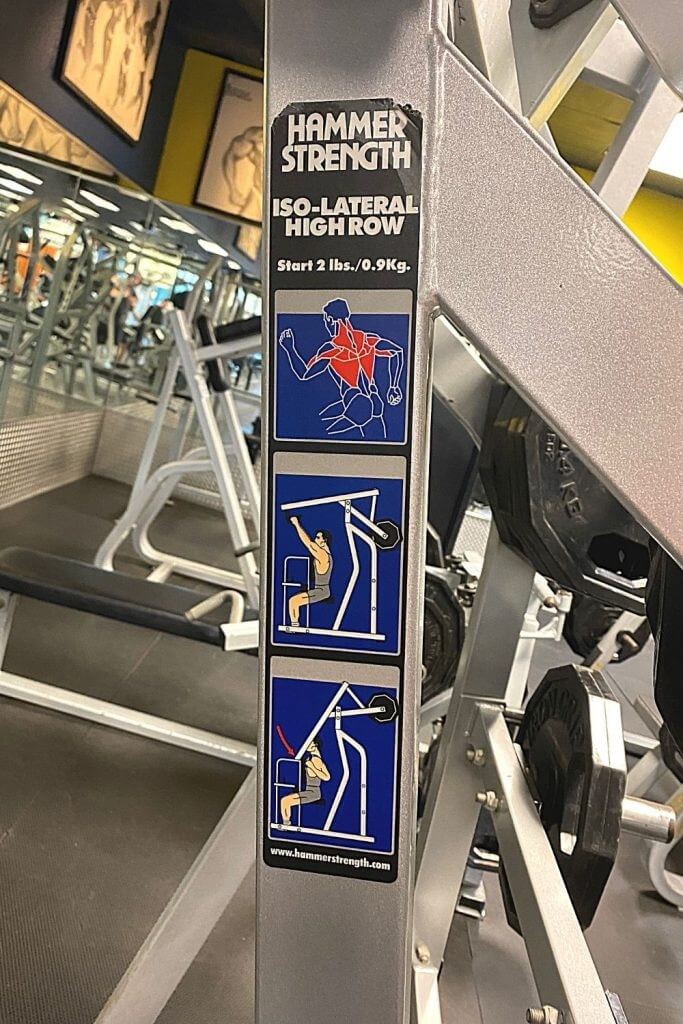
At first, you’ll think you’re performing sitting cable rows when you perform the iso-lateral row. With the Hammer Strength row machine, the difference is the ability to position your body to engage your back muscles more efficiently.
You’ll want to take advantage of the machine’s deeper muscle contractions and increased range of motion.
Iso-lateral row, as performed by Hammer Strength:
- Adjust your seat to a position that will best target your back muscles while you pull, just like you did with the high and low rows.
- Maintain a tight grip on the pad with your body.
- Squeeze your back muscles as hard as you can at the top of the exercise.
- Don’t stop too short on this kind of row, as it’s easy to do; achieve that wonderful, complete stretch.
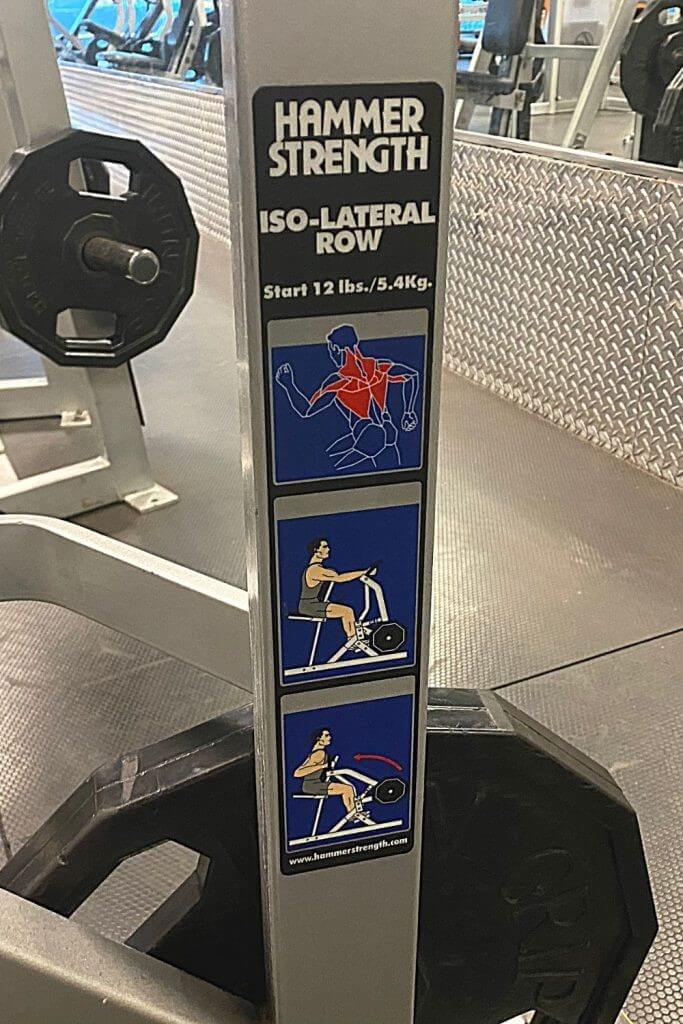
As you can see in the figure below the title of this section, this specific iso-lateral row also includes several grips. This provides you many more alternatives to provide additional detail in certain sections of your back muscles.
The Hammer Strength One-Arm Row was created to increase one’s strength.
The Hammer Strength One-Arm Row is a machine-based workout that primarily targets the lats (latissimus dorsi), but it may also be tweaked to target the rear deltoids and rhomboid muscles.
Hammer Strength One-Arm Rows Requires the Following Equipment
Since you may expect, the name of this workout is self-explanatory, as it can only be done if your gym has a hammer strength one-arm row machine.
One-Arm Rows with Hammer Strength Difficulty
Hammer Strength One-Arm Rows score between a 2 and a 3 on a scale of 1 to 5, since the resistance is on a “track,” allowing you to concentrate more on mentally focusing as much stress onto the lat as possible – which is one of the most challenging things for individuals to accomplish when training the lats.
How to Perform One-Arm Rows with Hammer Strength
To execute Hammer Strength One-Arm Rows, first set the seat height to the proper level – one that allows for a smooth, continuous contraction of the lat.
If the seat is too high, your hand will be too low while clutching the handle, causing the action to resemble a straight-arm pulldown variant, in which you will be restricted in how much weight you can utilize owing to biceps involvement.
If the seat is too low, on the other hand, your write is too high when you grab a handle, cause excessive el boom flexion and put more significant strain on biceps at the expense of the lats – that may also be a limiting factor in the weight you can use.
Your forearm will be nearly parallel with the floor when the seat is adjusted to the right height for your body’s measurements, but feel free to raise or lower the center as required depending on how the action feels to you.
Once you’ve adjusted the seat height and gripped the handle, use your opposite arm to support your body and draw the handle back, snug against your body, preventing your elbow from flaring outwards.
Hold the contraction for 1-2 seconds before carefully decreasing the weight back to the starting position before moving on to the next rep.
When it comes to Hammer Strength One-Arm Rows, there are a few things to keep in mind.
- Make sure the seat height is appropriate for your physique.
- To support your body, use your opposite arm.
- Pull the grip closer to your body while maintaining your elbow snug against your body.
- Squeeze the lat as hard as you can for 1-2 seconds before gradually dropping and moving on to the next exercise.
When doing Hammer Strength One-Arm Rows, how many repetitions should you do?
When doing the Hammer Strength One-Arm Row, the number of repetitions you should do is determined by your degree of expertise. Because this machine is relatively safe in comparison to other free-weight row versions, an experienced lifter may reap significant benefits by loading it up and doing 6-8 repetitions.
Those who are more novice or intermediate should go lighter, aiming for 10-12 repetitions and concentrating on tightening the appropriate muscles as firmly as possible throughout their set. It makes little sense to throw on the weight merely for the heck of it if you can’t efficiently contract the relevant muscles.
When it comes to Hammer Strength One-Arm Rows, there are a few common blunders to watch out for.
The following are some of the most typical errors made while completing overhand barbell rows:
Adding too much weight
can be tempting to add more weight to this exercise simply because it is a relatively safe exercise. Still, if the weight is too heavy, you may find yourself generating momentum to initiate the movement, reducing the demand on the muscles you wished to train when you first chose the Hammer Strength One-Arm Row.
Failure to adjust the seat height to the right level
– as simple as this may appear, many people are either too lazy or uncertain how to do it. So they leave it at the height the previous person placed it. This exercise might wind up tilting the scales in favor of greater danger and less profit if the seat is not positioned at the optimum height for YOU.
Failure to regulate the weight –
Because this machine may be loaded safely. Many people will take advantage of it by pressing much harder than is necessary in order to lift more weight or do more repetitions. As a consequence, non-lat muscles, such as the biceps, are used to raise the importance of the workout.
The Hammer Strength One-Arm Rows have been modified.
The elbows should stay close to the body since this is the motion plane where the lats are most active. If you wish to target more of the mid-back (rhomboids, traps), or rear delts, hold one of the handles farther away from the body’s midline and row with your elbows flared out to the side.
This allows for more efficient elbow flaring and places the back deltoids and rhomboids in direct opposition to the resistance.
When Should You Perform Hammer Strength One-Arm Rows?
Hammer Strength One-Arm Rows should be performed at the conclusion of a back workout after you’ve completed some free-weight exercises, which should be done earlier since they need more coordination. The more exhausted you are, the higher the danger of injury, so do them while you’re fresh.
Because of the enhanced stability given by Hammer Strength One-Arm Rows, fatigue won’t have as much of an influence on performance. Thus they may be done towards the end of a workout and still give a significant benefit.
Alternatives to One-Arm Row with Hammer Strength
A one-arm dumbbell row is the most similar option to the Hammer Strength One-Arm Row. So if your gym doesn’t have this piece of equipment, it would be your best option. One-arm cable rows, in addition to one-arm dumbbell rows, might be a suitable option.
One-Arm Dumbbell Rows compared. Hammer Strength One-Arm Dumbbell Rows
Although one-arm dumbbell rows and hammer strength one-arm rows are similar, there are a few key distinctions.
For example, it’s much simpler to balance oneself with the Hammer Strength One-Arm Row. Since you’re not fighting gravity (which is dragging you down toward the floor) and the resistance is on a “track.”
The one-arm dumbbell row, on the other hand, necessitates bending down and stabilizing yourself with your opposite hand while simultaneously maintaining your whole bodyweight. Because the weight isn’t on a “track,” it’s simpler for the form to deteriorate, lowering the exercise’s efficacy.
Imagine the difference between a machine-assisted Hammer Strength One-Arm Row and a dumbbell-assisted One-Arm Dumbbell Rows workout.
Hammer Strength Iso-lateral Row for Back Exercises
Are you prepared for some incredible back exercises that will help you grow muscle? I’ll show you three exercises that you can perform with Hammer Strength iso-lateral rows below.
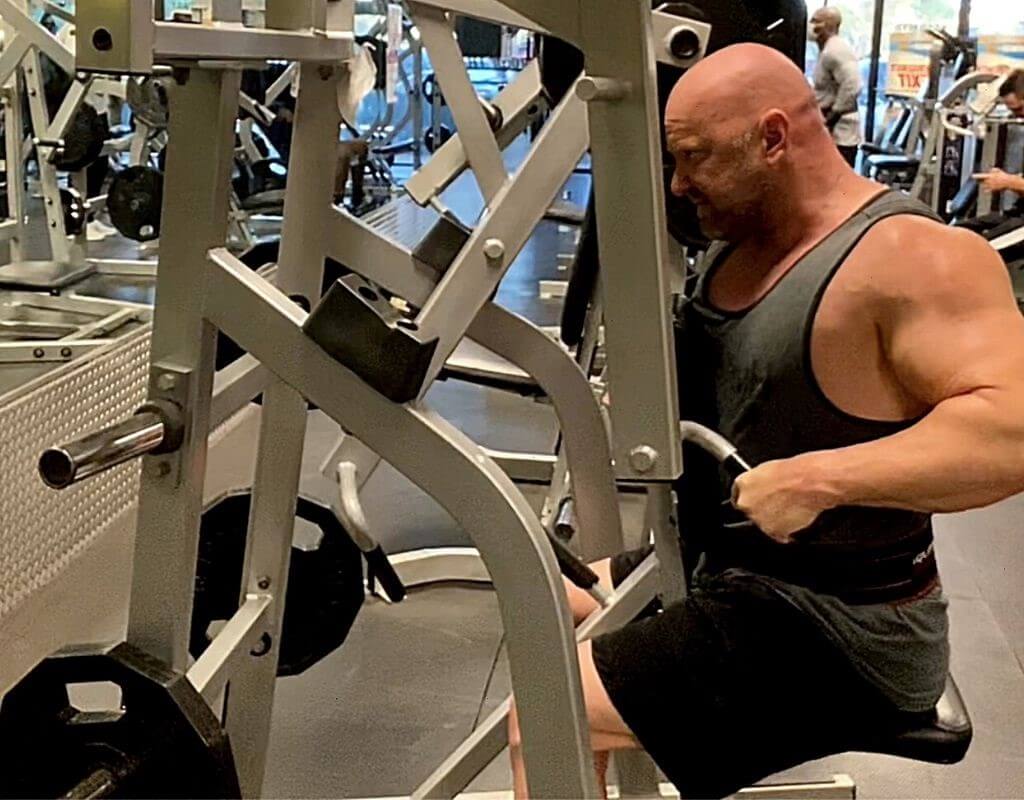
Each exercise is designed to assist you in achieving a certain goal. For the last session, you’ll just utilise these Hammer Strength iso-lateral row machines (you’ll also see a video of it).
Back Workout No. 1: Mass Gain
This first back workout is a bodybuilding routine that emphasizes muscle mass gain. You’ll begin with compound exercises and work your way down to isolation exercises. Which is when the Hammer Strength rows will be performed.
[table id=13 /]
Back Workout 2: Slimming Down
Following that, a back training plan for muscle definition and weight loss is shown. This is where you’ll get a little more in-depth with making your muscles work harder. To accomplish so, you’ll begin by pre-exhausting your muscles with a Hammer Strength row exercise (this one will be very challenging!).
[table id=14 /]
**Pre-exhausting your muscles is an excellent technique to make them work harder for the remainder of your exercise. Doing unilateral rows will increase the intensity of your pre-exhaust.
Back Workout 3: All Hammer Strength Row
In the last workout, only Hammer Strength rows are employed. We’ll do all three of the iso-lateral exercises we mentioned before. You’ll also play around with other variations of each.
You’ll go through the following steps in the sequence shown below:
Iso-lateral rows
- Low rows that are iso-lateral
- High rows that are iso-lateral
You’ll also see that you’re using numerous procedures for each version of low. You may change the number of sets and reps to suit your needs. This is also the workout shown in the video below.
[table id=15 /]
You may grow a tough muscle back. It is not visible as the rest of our upper muscles, which makes it more difficult to link the mind-muscle.
But as you saw in this piece, Hammer Strength improves the efficiency of certain equipment to train your back. You may grow a vast and defined back with a greater range of motion and the capacity to obtain those deeper muscular contractions.
I hope you’re at your gym with this equipments. If so, attempt one or all the back exercises I’ve given you!